![[MetroActive News&Issues]](/gifs/news468.gif)
[ Santa Cruz | MetroActive Central | Archives ]
A Mushroom of One's Own: Lee Yamada shows off the fungal fruits of his labors.
Spreading The Spawn
Can insects farm fungi? Was Jesus tripping on 'shrooms? Are mushrooms from outer space? Fungus farmer Bruce Meads and other spore specialists tackle the big questions.
By Sarah Phelan
WHAT DO leaf-cutting ants, mound-building termites and Bruce Meads have in common? All three are fungus farmers. At first glance, the similarities appear to end there. Over 6 feet and with a Braveheart-like head of hair, Meads is way taller and hairier than his invertebrate counterparts. And while he grows gourmet mushrooms in a trailer-turned-laboratory, the bugs, working in underground gardens, cultivate fungi that converts their otherwise unassimilable food sources into digestible, nutritious biomass.
But dig a little deeper, and you'll find that as facilities manager of Full Cycle Farms, Meads follows the same golden rules as his buggish counterparts: he establishes pure cultures of fungi, keeps them supplied with food and moisture, and weeds out contaminants.
Why would anyone farm fungi in the United States, a nation that suffers from advanced fungophobia, a condition we inherited from those tea-sipping Brits? Devil's Stinkhorn, Witches Butter and Slippery Jack: these common names for edible and, in other cultures, highly valued mushrooms speak volumes about the fear and loathing that surround fungi in our nation. Indeed, our appreciation of mushrooms seems to begin and end with Agaricus brunnescens, the small, white, bland-tasting specimen that dominates supermarket shelves to the virtual exclusion of almost any other fungi.
As Meads will tell you, he didn't get into the business for the money.
"My interest got sparked when I took Patrick Elvander's mycology class at UCSC," he says. " Elvander would tell us to go out into the woods and collect deer shit to see what would grow on it, and I've been hooked ever since."
Today Meads understands what the insects have always known: fungi have myriad uses as food and medicine, most of which have gone untapped by North Americans. Yes, the hills are alive with the spawn of fungi--and Meads, who has already successfully cloned oyster, shiitake and reishi mushrooms at Full Cycle Farms--hopes to clone them all.
Ground Control: Fungus farmer Bruce Meads studies the intricate relationship between wild mushrooms and trees.
No Picnic
--The Fifth Kingdom
WITH 70,000 identified species and thousands more uncharted, fungi rival flowering plants in terms of biodiversity. Awesome agents of disease and decay, they outweigh the animal kingdom in terms of biomass, drive the global carbon cycle, sustain our forests and grasslands, and cover, in the form of lichens, areas of the planet that would otherwise stand bare.
Without fungi, there would be no flowers or forests. Without them, no beer, wine or cheese. Without fungi, forget about that picnic. And that would be a shame, because Meads has invited me to tour Full Cycle Farms, hunt the wild mushroom and stay for a picnic lunch.
But when I arrive at the facility, which lies on a 10-acre ranch at the end of a dirt road somewhere in the wilds of Corralitos, I begin to wonder about the wisdom of this plan. Dressed in a pair of bleach-stained jeans and a T-shirt that features colliding banana slugs, Meads looks every inch the mad scientist as he greets me, flanked by twin Labradors Zen and Xena, who bark excitedly.
"Time for your shower," smiles Meads, opening the gate. He's not joking.
"To visit the laboratory, you need to be squeaky clean, no exceptions," he says, as he leads the way to a ranch house half-hidden by cascades of orange nasturtiums and scarlet bougainvillea. Ten minutes later, I re-emerge, freshly showered, and promptly follow the now dog-free Meads along an oak leaf-carpeted path. We pass a rusted-out van, two rusty wheelbarrows, three rusty rakes and an overgrown vegetable patch, heavy with pale-white gourds, then descend into a clearing occupied by two white trailers.
One trailer is adorned with a poster of Xena the Warrior Princess, clad in knee-high leather boots. The other, which is hung with a World War II gas mask and fairy lights, belongs to Meads' business partner, Temoc Rios. Although both trailers look like they escaped from the set of an X-Files episode, they actually have academic pedigrees of sorts, dating back to the days when Meads and Rios both lived on the UCSC campus in the same trailer park.
"About six years ago, Temoc decided to convert his trailer--the one with the gas mask and fairy lights--into a lab for the cloning and propagation of fungi," says Meads, who got involved in the business later, once Rios had graduated from UCSC.
"Temoc parked his 'lab' in a driveway he had rented across from the Bagelry and established a grow room in a nearby hippie co-op. For a while the two of us churned out jars of spawn, which we then drove the few blocks to the hippies," Meads explains.
Unfortunately, the grow room didn't work out because of contamination, which, Meads claims, either came from the location, or from lack of sobriety on the part of the staff. It was the duo's first true lesson in the importance of the clean technique, a practice they follow religiously at the reborn Corralitos-based Full Cycle Farms, which sells fresh and dried oyster mushrooms, along with oyster and shiitake starter kits and spawn dowels.
Photograph by George Sakkestad
Steamy Retort
'FIRST, LET me introduce you to Bertha, our autoclave, our sterilizer. She is the heart of the operation," Meads says, guiding me toward a battleship-gray steel retort (a.k.a. sterilizer) that is squatting between the two trailers. According to Meads, life was difficult B.B.
"Temoc was using a small pressure cooker," he explains, "which was way too small for the job, and then, one day, as he was driving through Hayward, he saw this 4-foot-tall, 3-foot-wide retort sitting beside the road. And like any man who has just seen an incredibly beautiful thing, he screeched to a halt, and there was this old man sitting on a front lawn surrounded by a bunch of steel equipment. The old man turned out to be the retired Pickle King, and Bertha was his retired sterilizer. And since Temoc only had $80 in his pocket, $80 was the price they agreed upon."
The tale over, Meads reaches into the depths of Bertha's belly and pull out a bag of ... wood chips?
"Wood chips," says Meads, as the strong aroma infuses the forest air, "are the spawn's favorite food, and they need to be sterilized, if you're gonna give the particular spawn you're trying to cultivate a head start. You see, the biggest enemy a fungus has is other fungi."
Three times a week, Meads fills Bertha's belly with bags of wood chips and feeds her superheated steam, until Bertha gets above 15 psi (pounds per square inch), which, Meads explains, "is the point at which you're gonna kill all normal fungus or bacteria and have bags which are sterile and ready to be inoculated with spawn."
But what exactly is spawn?
"Spawn is another name for the mycelium, which is the treelike part of the mushroom," Meads explains, "only in the mushroom's case, the 'tree' part remains leafless and underground, digesting nutrients in an intricate web of fine tubes and periodically producing fruits, which pop up above ground and which we call mushrooms."
Alien Spawn
BEFORE ENTERING the trailer-turned-lab, Meads insists that we take off our shoes, wash our hands and don rubber gloves. And if that isn't enough, he turns on a blower, which forces a stream of sterile air into the trailer through a filter, which removes unwanted bacteria and spores. All of which makes me wonder what fungus-farming insects do.
"Ants have chemical inhibitors in their saliva and anal fluid. And the termites, well, they mostly eat the competition," says Meads. Glad not to be an insect, I watch as Meads prepares to clone a wild chanterelle, which he found growing under an oak tree earlier that morning.
"Cloning is a particular useful technique for gourmet mushroom farmers, because clones are identical in taste to the original mushroom," continues Meads, cutting off a piece from the chanterelle's vase-shaped cap and washing it with alcohol, before setting it in a petri dish filled with aqua solution.
"Usually, I wait a few days, and if the mycelium grows, I cut it up and pour the mixture over sterile wheat in a jar. If spawn fills the jar, this growth will become the mother spawn from which other jars will be inoculated."
Leaving the cut-up chanterelle in its dish in the cloning hood, we climb the few short steps into the laboratory, which has a futuristic feel on account of reflective silver wall panels and shelves upon shelves of spawn-filled jars. Meads reaches for a jar labeled "PO 13" and unscrews it. The odor of walnuts fills the room.
"This is the spawn of Pleurotus ostreatus, otherwise known as the oyster mushroom." Meads uses Latin binomials to identify specimens, because he finds common names misleading and inaccurate.
But why PO 13?
"Now that is a trade secret," says Meads, cutting up the spawn and pouring it into a bag of wood chips, which he then squidges between gloved hands. Once he's finished spreading the spawn, Meads checks the jars and bags in the lab for signs of any unwanted fungal growth, easily recognizable because they're green, but hard to control because they're spread by airborne spores.
"Some people believe that fungi came from outer space as spores, that they are the original intergalactic communicators, but I don't agree. Their DNA base is too similar to other organisms on the planet, and they fit too easily into evolutionary patterns," says Meads, as we emerge from the lab into the winter sunlight.
He spreads a tarp on the floor, and for a moment I think we're about to have the much-anticipated picnic. But then Meads dashes my hopes by sprinkling the tarp with wheat spawn and rolling it into a chicken-wire column, which he then fills with straw.
"Each mushroom has different spawning needs," he says, hanging the straw-filled column up in a duct-taped bag under a nearby pine tree. "Oyster mushrooms do well on straw, shiitake and reishi do well on wood chips and chanterelles like to be connected to the roots of oak trees."
Dirty Faces: Lee Yamada uses a brush to clean a mushroom's mud- and twig-thatched cap.
Friend of Trees
THE FACT that many mushrooms grow in symbiotic relationships with trees has led Mushrooms Demystified author David Arora, among others, to suggest that growing wild mushrooms is not such a good idea.
"In Oregon and Washington, some forests are more valuable for their mushrooms than their trees," says Santa Cruz resident and wild mushroom hunter William Rubel. And since mushrooms need trees to flourish, this has strengthened the argument for an end to the clear-cutting of trees.
"But if you farm mushrooms, you undermine that argument," Rubel says.
Couldn't wide-scale mushroom hunting lead to some fungi's extinction?
"You can no more harm fungi by picking the mushrooms than you can hurt an apple tree by picking the apples," says Rubel.
So where can a poor girl pick mushrooms, anyway? According to George Gray, ecologist for California State Parks, Santa Cruz District, it's illegal to gather wild mushrooms in state and city parks.
"State parks are preserves where you don't take or harvest things whether they are flowers, fungi or animals. Parks are areas that are supposed to look like natural places, without humans," says Gray, adding that people who get caught picking mushrooms will get warnings first and then citations.
Such attitudes make Rubel and other mushroom hunters see red.
"There is a historic connection between humans and forest. This is a way to interact with the forces of nature that is more intimate than riding a bike or jogging along forest trails. When you collect wild mushrooms, you are being a hunter-gatherer," says Rubel.
"Rangers are frustrated cops," says Phil Carpenter of the Fungus Federation of Santa Cruz, which organizes fungus forays and offers classes in identifying mushrooms.
Rubel, who has hunted wild mushrooms for years, maintains that identifying mushrooms is no big deal: "If you're capable of telling a navel orange from a Valencia orange, or a parsnip from a carrot, then you have what it takes to identify a poisonous mushroom from its nonpoisonous counterparts."
Phyllis Cole of FFSC takes a more cautionary approach. "In the field guides, mushrooms all look pristine, but in nature they have dirty faces," she says.
Lee Yamada, who often leads FFSC's fungus forays in pixielike mushroom-print pants, says the Santa Cruz mountains are home to between 3,000 and 4,000 types of mushrooms. Of these, about 30 are choice eating mushrooms, a few cause hallucinations, and a dozen are deadly.
His advice? "Learn about the poisonous ones first."
No kidding. In early December, three Mexican immigrants were admitted to the Community Hospital of Monterey Peninsula, suffering from serious liver damage after ingesting the deadly poisonous Amanita phalloides, otherwise known as the Death Cap.
"Apparently, they mistook it for another nonpoisonous mushroom from Mexico, cooked it up and ate it in a burrito," says Nancy Gere, director of the hospital's Communications and Marketing. All three were transferred to UCSF Medical Center for liver transplants but were successfully treated with drugs.
Herbalist Christopher Hobbs, author of Milk Thistle: The Liver Herb, laments that though milk thistle has been used extensively to treat amanita poisoning in Europe, the Center for Disease Control refuses to recommend the herb.
"In Germany, they have been able to reduce the death rate to zero just by giving injectible silymarin, which is the active flavonoid mixture from the seed coating. ... Every year some people ingest Amanita phalloides on the Central Coast and have to have a liver transplant and some people die. These deaths could be completely avoided," he says.
Heart of the Operation: Meads feeds Bertha the Retort's belly with jars of grain for the spawn.
Mushroom Rap
THE SUN is high in the sky as Meads and I, followed by the ever-faithful dogs, take off on our long-awaited fungus foray. We plunge down a gully, along a muddy trail, flanked by ferns, brambles and lichen-coated branches, and come across a whole hillside of Amanita muscaria, the red-and white-spotted mushroom of fairy-tale fame.
"Some people say this mushroom is a metaphor for the universe--the marks on the cap symbolizing the galaxies, the growing cap being the expanding universe," Meads tells me.
"Others say reindeer are addicted to them, which may explain how Santa got Rudolph to fly. One thing seems sure. These mushrooms are one of the oldest intoxicants known but are extremely harsh on the body, while only containing a mild hallucinogen. However, this hallucinogen is converted into a far more powerful intoxicant, which gets filtered out into the urine.
"Evidently, Siberian nomads must have figured this out, because they'd follow the reindeer across tundra and collect their piss, which was probably the best high you could get in Siberia at the time," says Meads, adding that a disproportionate number of people seem to have mistaken themselves for Jesus Christ while tripping on these 'shrooms.
Was Jesus Christ really a 'shroomer? Are fungi our first contact with outer space?
These questions rattle around in my head as we return to the ranch bearing a cauliflower mushroom, a brainlike mushroom that was growing at the base of a pine tree and a heart-shaped King Bolete, almost the size of an elephant's ear, which we found growing under a fir.
I sit on the porch outside the ranch soaking up the sun, as Meads cuts the bolete into cross sections, revealing maggot trails, which ascend the thick white stalk all the way up into cap, momentarily putting me off lunch.
"Don't worry, I wouldn't eat it either, but some people slice and dry the boletes and wait until the maggots are dead and gone," laughs Meads, as he chops fresh oyster, shiitake and cauliflower mushrooms into thin slices and sautés them in olive oil and garlic over a portable heater. He mixes up eggs, pours them over the mushroom mix, and while all this is cooking, he gathers nasturtium leaves, which, as I soon discover, have a mild wasabilike flavor. He also gathers handfuls of orange nasturtium flowers.
When the omelet is ready, Meads carves it into 1-inch squares, wraps each square in its own leaf and tucks in a flower as a kicker. He spears the whole thing with a toothpick and voilà! Sitting before me is a delicate, delectable feast, a fitting tribute to fungi, the Fifth Kingdom, which make this and all other picnics possible.
[ Santa Cruz | MetroActive Central | Archives ]
Copyright © Metro Publishing Inc. Maintained by Boulevards New Media.
![]()
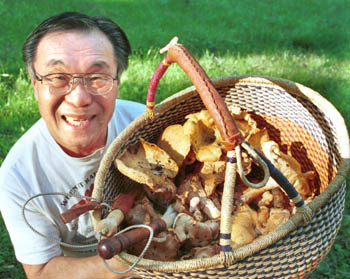
Photograph by George Sakkestad
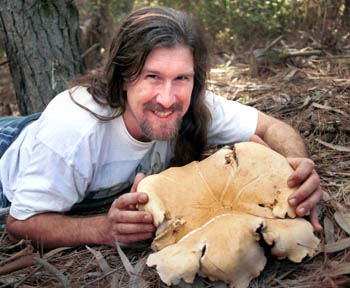
Photograph by George Sakkestad
Imagine the picnic of your dreams. You and your loved ones float across a flower-filled meadow, coming to rest under the shade of a giant white pine. There you spread out the magic ingredients--the champagne, wine, or beer, the fresh crusty bread, the pâté au truffle, the creamy Camembert, Brie or Roquefort cheese. ... Up to this point your tryst is a tribute to the beneficent influence of fungi on our diet and scenery.
Bryce Kendrick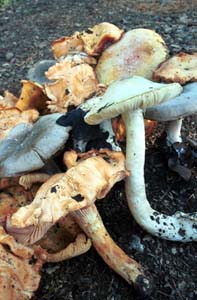 Spores the Merrier: Mushrooms are the spore-filled fruits of the mycelium, the mushroom's underground 'tree.'
Spores the Merrier: Mushrooms are the spore-filled fruits of the mycelium, the mushroom's underground 'tree.'
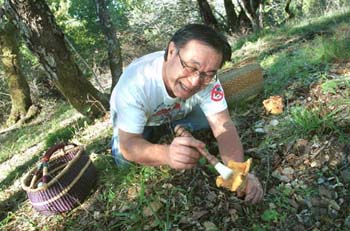
Photograph by George Sakkestad
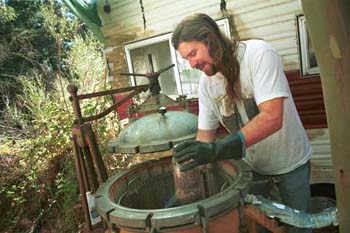
Photograph by George Sakkestad
Bruce Meads, Christopher Hobbs, Lee Yamada, Phyllis Cole and Phil Carpenter will be participating in the 27th Annual Fungus Fair, Jan. 13-14, at Louden Nelson Community Center, 301 Center St., Santa Cruz. Call 831.420.6115. For Full Cycle Farms check online at www.fungi.com or call 786.9445.
From the January 10-17, 2001 issue of Metro Santa Cruz.